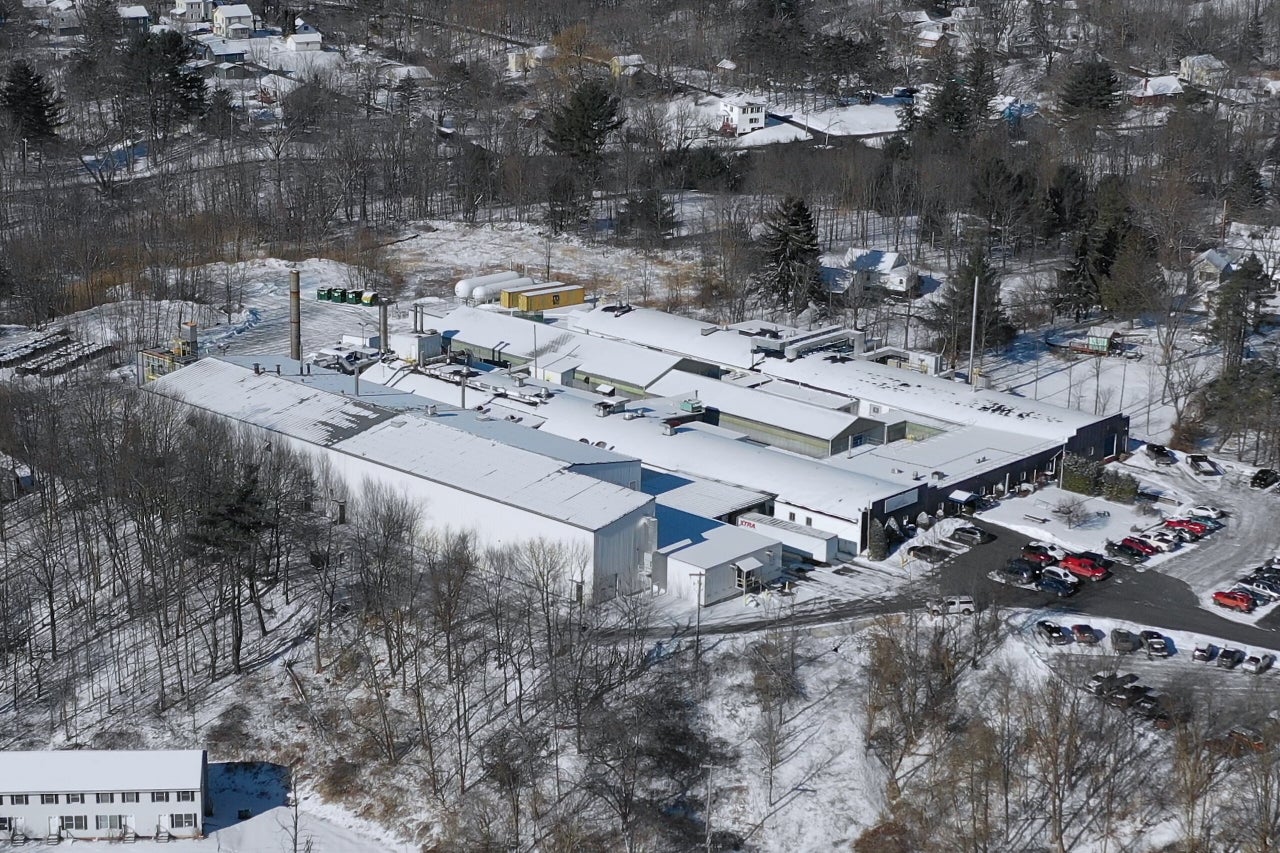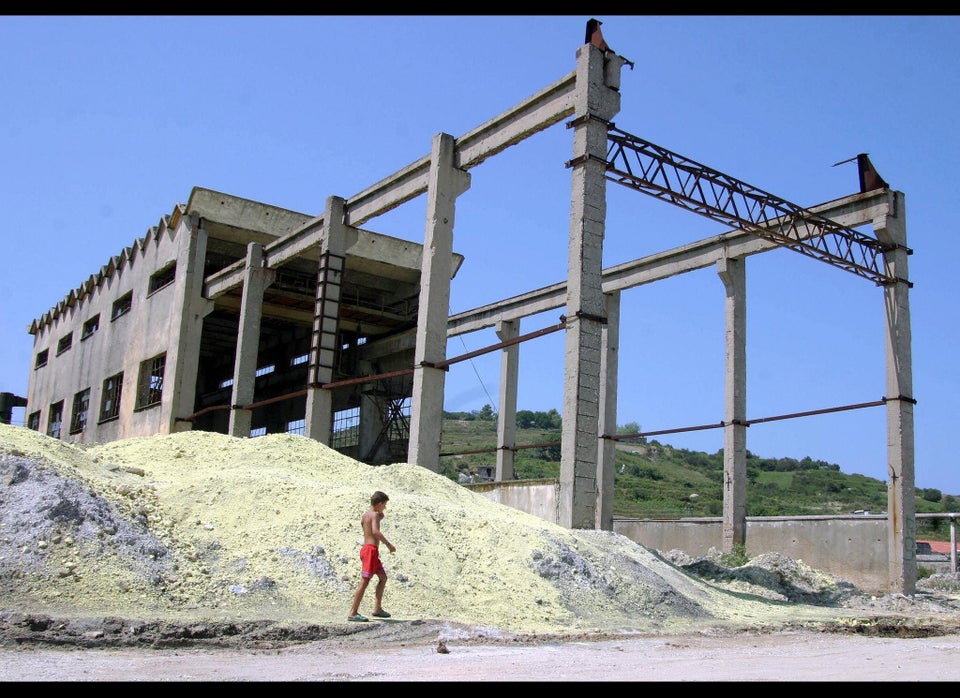HOOSICK FALLS, N.Y. ― It’s been five years since Michael Hickey, sleepless and grieving his father’s untimely death, Googled “Teflon” and “cancer” and came to the terrifying realization that his town’s water was likely poisoned.
Back then, perfluorooctanoic acid, or PFOA, was little more than a chemistry textbook tongue twister. It was also the key, nonstick ingredient in the waterproof fabrics made by the factory almost next door to the Hickeys’ home.
The entire family worked at various points in the plant, owned first by Honeywell International then Saint-Gobain Performance Plastics. Hickey recalled scrubbing the ventilation towers as a young man in little more than light protective gear. Hickey’s father was driving a school bus for the town the day he came home and urinated blood, offering the first visible sign of the kidney cancer that would kill him not long after. His death haunted his son. Hickey’s father never drank or smoked; he was relatively fit. How could he get cancer?
While he strongly suspected their water was tainted, Hickey couldn’t even convince local or state officials to test the water supply for the chemical and ended up doing it himself. The results were definitive: The tiny upstate New York mill town’s groundwater contained chemical levels far exceeding the Environmental Protection Agency’s health advisory.

At the time, the problem seemed isolated and far too complex to attract the same national attention as the water crisis in Flint, Michigan. That’s because the lead poisoning that affected Flint is fathomable to anyone who’s inspected old paint while hunting for housing. PFOA, by contrast, remains an abstraction.
But those assumptions could soon prove wrong as more local contamination stories come to light.
Today, PFOA, which is part of a family of commonly used chemicals known as per- and polyfluoroalkyl substances, or PFAS, looms as the nation’s most widespread and least understood environmental health crisis. Its causes mirror those of climate change ― industrial discharges, the production of cheap creature comforts, military pollution, years of disinvestment in public infrastructure and oversight. Yet recognition of the issue of PFAS, complex and scientifically dense as it is, is a rare point of bipartisan agreement in Washington.
What to do about it is another story. In April, the Environmental Protection Agency significantly weakened a proposal to set new standards on PFAS under pressure from the Department of Defense, a major source of the contamination.
As a growing number of Democratic presidential candidates released detailed plans to curb human-linked emissions of planet-warming gases, there are few concrete ideas about how to relieve the estimated 19 million Americans whose drinking water contains so-called “forever chemicals” that never biodegrade.

Hoosick Falls eventually sued the multinational chemical giants. Last June, the town won a second settlement of $200,000 ― less than $60 per resident. The case stands out not only for the dramatic discovery of the contamination, but because the polluters faced some justice.
In many of the 610 PFAS sites now identified in 43 states, the military is the source of the contamination ― largely due to discharges of firefighting foam laden with perfluorooctanesulfonate, or PFOS.
The presence of such military sites in states where 2020 contenders are bound to compete aggressively could push PFAS into the mainstream political debate.
“There are many battleground states where PFAS is, after climate change, the single biggest environmental and public health issue,” said Scott Faber, vice president for government affairs at the nonprofit Environmental Working Group. “Places like West Virginia and Ohio, where there are industrial discharges but also a history of military air bases using a lot of foam.”
In Washington, things are already heating up. Congress held multiple hearings on PFAS this month alone. At least 19 bills to deal with PFAS are making their way through Congress now. Among them is legislation mandating testing for at least 30 types of PFAS chemicals in all public water systems in the United States. The results could be devastating.
“As people discover contamination of their drinking water, they become very concerned and would support those who want to solve the problems,” said Arlene Blum, executive director of the California-based Green Science Policy Institute. “The question is, will people vote because of PFAS?”
“The question is, will people vote because of PFAS?”
- Arlene Blum, Green Science Policy Institute
It’s a question weighing on the campaign of one of Hickey’s senators, Kirsten Gillibrand (D-N.Y.).
“It is the EPA’s job to protect Americans from highly toxic chemicals like PFAS, but they have failed to do what is necessary to help ensure our families in New York and across the country are no longer exposed to dangerous levels of PFAS in their drinking water,” Gillibrand said in a statement. “This is a widespread crisis that is putting the health of millions of Americans at risk.”
Gillibrand is the only major 2020 contender who has laid out a specific policy platform on PFAS. Other candidates have included water infrastructure overhauls in their comprehensive climate proposals that would likely benefit communities contaminated by the chemicals. But they don’t singularly address this contamination crisis.
Jay Inslee, the Washington state governor making a White House bid entirely focused on climate change, vowed to spend billions on drinking water infrastructure as part of his $9 trillion economic plan. Former Texas Rep. Beto O’Rourke’s 2,500-word climate platform mentions water seven times, and in a statement to HuffPost, called for “strong, science-based standards” and phasing out “the use of these toxic chemicals while holding polluters accountable and investing in communities impacted.” Joe Biden, the former vice president and frontrunner in early polls, put forward a climate plan Tuesday that includes overhauls to drinking water infrastructure.
Marianne Williamson, the spiritual guru and activist running for the nomination, said she’d “establish a legally enforceable limit for PFAS chemicals in drinking water. I would identify the sources of PFAS contamination and stop it at the source.”
Others have been specific on the issue, if not on policy. Sen. Kamala Harris (D-Calif.) called the EPA’s decision in February to delay setting a standard for PFAS in drinking water “completely unacceptable.” Former Maryland Rep. John Delaney called for “additional funding for monitoring and testing of PFAS levels” and studies of health impacts in contaminated communities.
President Donald Trump seems ready to tout the nominal efforts the EPA has made to regulate PFAS under his administration.
“President Trump is committed to ensuring that Americans have the cleanest possible water,” a campaign spokeswoman said by email. “Under his leadership, the EPA has taken unprecedented action to protect Americans across the nation and provide sustained access to clean water.”
For Hickey, it’s a relief to see the issue at least starting to gain currency. Hoosick Falls’ contamination became a major sticking point during New York’s heated gubernatorial primary last year as Cynthia Nixon, Gov. Andrew Cuomo’s progressive challenger, made repeated visits to the town.
In February, Hickey attended the State of the Union address in Washington as a guest of Rep. Antonio Delgado (D-N.Y.), the freshman congressman for his district.
“It doesn’t matter if you’re Republican or Democrat, you’re seeing contaminations come up in all these areas now, and it has to be dealt with,” he said. “But, this being a Republican president right now and a Republican EPA … they don’t want to deal with it. Hopefully, if a Democrat wins the presidency, we’ll actually get some change.”
